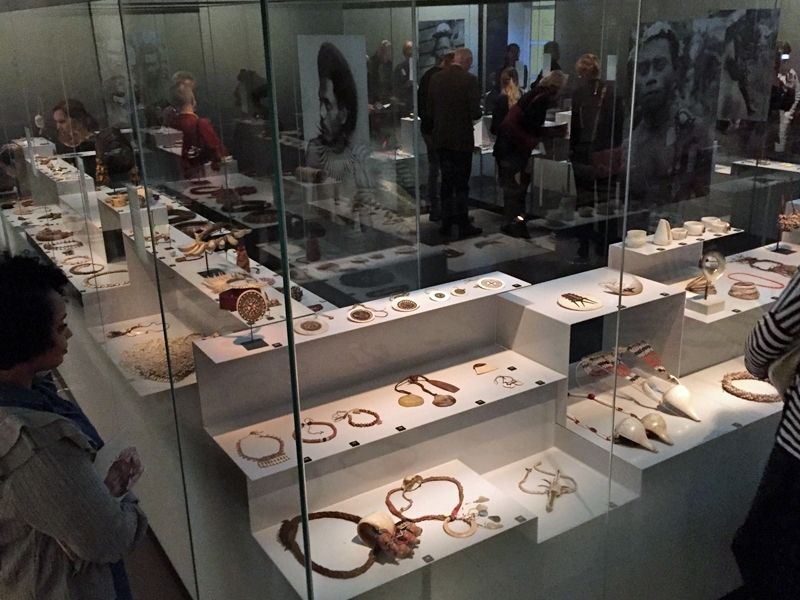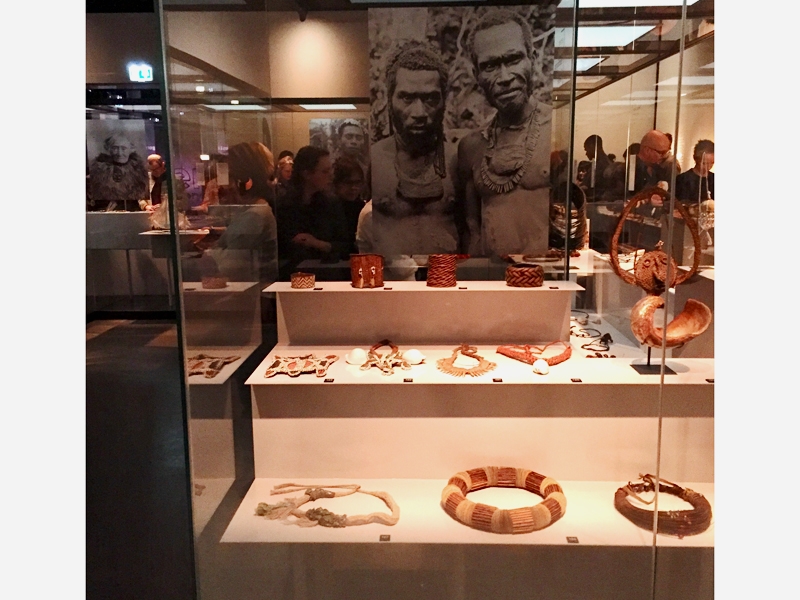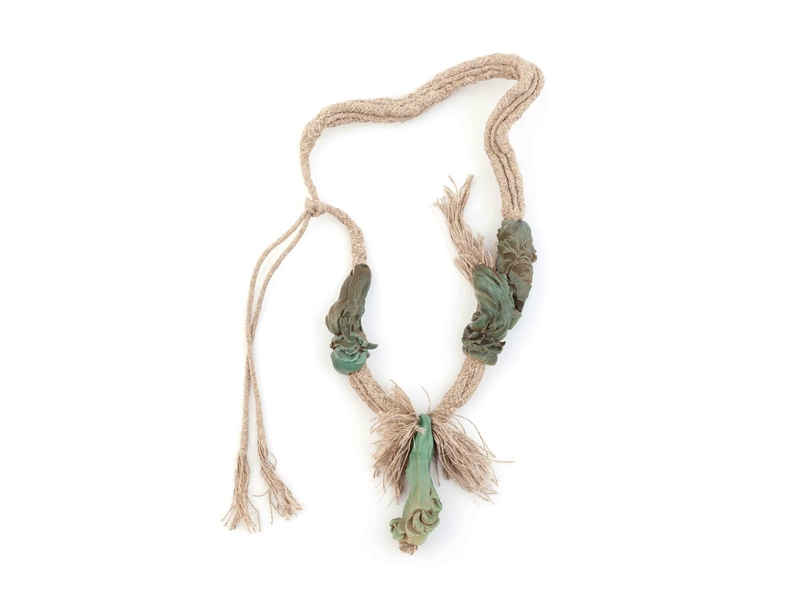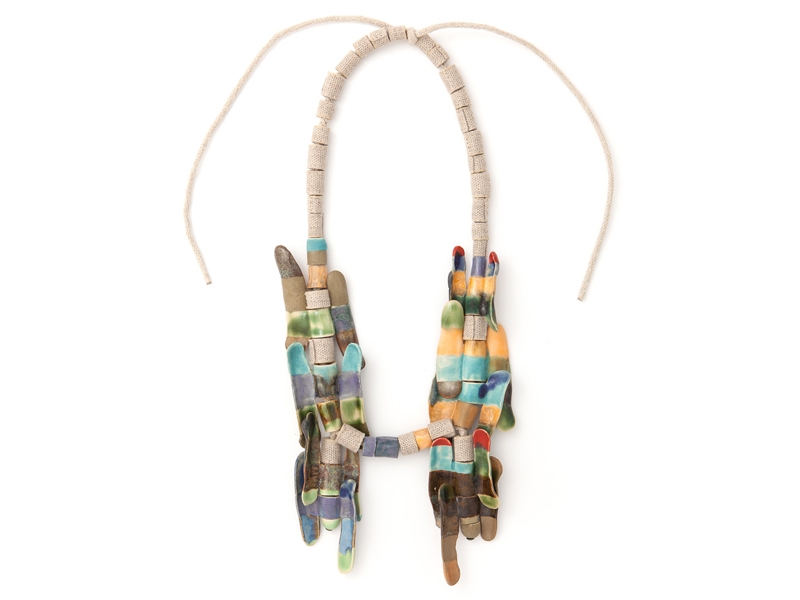December 13, 2017–June 3, 2018
Museum Volkenkunde, Leiden, the Netherlands
A Feast
One of the most renowned Dutch museums of ethnology, the Volkenkunde, in Leiden, presents a feast for the eyes with its current big production. If you felt Médusa, in Paris, was a lot, that was just 400 pieces. Here, in Jewellery: Made By, Worn By, the total is one thousand.

To begin with, hundreds of pieces of jewelry were pulled out of storage, ranging from a Kundan Meena necklace from Bikaner, India, to Hombori marble upper armbands from Mali.[1] The objects date from a range of historic periods up until the present. In addition to the ethnographic collection, the visitor is treated to many excellent contemporary pieces on loan from art and jewelry galleries. The lineup is long and manifold: Jorge Manilla, Sam Tho Duong, Florie Dupont, Florian Milker, Karl Fritsch, Esther Brinkmann, and Johanna Dahm, to name but a few. Jewelry artists have long found inspiration in ethnographic objects or used them to interpret the roots of what is made today. In Jewellery: Made By, Worn By, the invitation works the other way around. Bringing in the new to present the old or the distant has been a successful mechanism in this museum before, but how does it work this time around?[2] An intriguing aspect is the exhibition design divided according to material, such as shell or silver. Reasons enough to examine the role “contemporary jewelry” plays in this exhibition.
Contemporary from All Corners of the World
In the first room of Jewellery: Made By, Worn By, I was stopped in my tracks by seven mesmerizing film portraits. Projected on life-size vertical, freely suspended banners, a mix of makers, gallerists, collectors, and wearers explain simultaneously that life without jewelry is possible, but incredibly boring! That energizing tone of commitment shifts to calm—factual, almost—in the following rooms, where hundreds of pieces are laid out.
There are historical pieces, the ones that once caught the eye of colonials, scientists, and traders in the second half of the 19th century, inventory numbers scribbled along the rim. In those days, countless objects got adrift from their cultures of origin and into collections in Western Europe. Apart from esthetics or anthropological interest, at the time the materials and craftsmanship of these objects were studied for their exploitable industrial potential. This is one of the reasons why in the Netherlands, which had colonies in Indonesia, Surinam, and the Caribbean, for example, collections of ethnographical objects are relatively comprehensive.

A remarkably large part of the exhibition, however, is of more recent date, acquired from regional contemporary makers. Among them are artists who kept close to their culture’s designs and others who honor their heritage by giving tradition a twist. Whereas Native Americans are known for using silver in their jewelry, Pat Pruitt, who is of Laguna, Chiricahua Apache, and Anglo descent, replaces the silver in his work with stainless steel and industrial diamonds. Peruvian goldsmiths remake pre-Columbian designs. Different as these recent makers are, they might have a point of departure in common: something that might be called a cultural community identity in their work. Another kind of object interjected throughout the concept is what—hesitantly—could be labeled contemporary art jewelry. Not all makers in this category are interested in connecting to a (lost) community identity in their work. Rather, a large number put something else in the foreground: an individual identity.
I make mention of my hesitance to use certain adjectives because language often reveals beliefs. Two years ago, the Rijksmuseum in Amsterdam removed offensive words like “negro” or “Indian” from the titles of artworks. Accused of political correctness, the museum persevered and hence started a valuable discussion. In the same light, the museum in Leiden would disapprove of using the word “contemporary” jewelry when used as opposed to ethnographic and as equivalent to modern, Western or—worse—advanced. In the same way, it avoids ethnographic as an adjective, along with traditional, ethnic, primitive, or non-Western. “If there is any distinction to be made,” guest- and assistant curator Vanessa de Gruijter says, “it would be between historical and contemporary where contemporary means nothing more than: of today.”[3] This exhibition certainly made me aware of how white my ivory tower is. Uneasy adjectives are to be dropped where possible, to steer clear of the Eurocentric pitfall. Still, I cannot help feeling a bit inconvenienced if I wanted to try to distinguish one category of jewelry from another after all.
Rewriting the Captions
A solid, illustrated handout (€2, and indispensable) gives background on every single piece on show. It states the material, date, geographical location of the maker, and technique: “spun by hand,” or “paper rolled up tightly,” or “fired at 1260°C.” In many instances, the text gives background on the relationship between object and maker or object and wearer. No poetry, no soul-searching. That single format, revolving around material and technical facts, is used for jewelry from all categories. For me this is a clear effort to level art-speak and material-culture-speak and to avoid placing one type higher on the design ladder than another. It’s a good reminder that captions always “frame” the meaning of a piece of jewelry.[4]
In this ethnographic museum, objects are presented differently from in an art and design context. Lights are turned low, probably to prevent natural materials from fading. Some pieces suffer from this: on Alejandra Solar’s Murmullos brooch, probably used to a lot more luxe in daily life, it is hard to detect the printed Aztec god. Tortoiseshell, real or the mimicked galalith in Julia Walter’s pendant, does not show its translucency. Refreshingly, none of the pieces are hoisted on the altar-like mounts we sometimes find in the art world. Since all jewelry is treated equally in visual and textual presentation, their analogies are easier to detect. I would argue this level playing field in Jewellery: Made By, Worn By is a firm step forward in the direction of the “larger context” wished for by some jewelry researchers.[5]

Strict Sections
Materials! What a bold choice for classification. The first room says Nature on the wall. Silver, Beads, and Gold follow suit. Every room contains tall, densely packed glass cases with subheadings like Stone or Shells. Thus we find Anish Kapoor’s enameled gold rings sharing a display with Aurélie Guillaume’s colorful copper brooch, Esther Brinkmann’s champlevé rings, and 21st-century enameled gold and gemstone jewelry from the Johari Bazaar in Jaipur, India.
In this home of material culture, I expected either a geographical layout or at least a ritual theme such as mourning or wedding jewelry. A non-hierarchical ordering by material is a fresh turn. Also, I’m guessing that ethnographic museums are treading on eggshells. A number of the objects they keep are tainted with the sorrow of their cultures of origin. Museum visitors from an ever-changing diverse society expect re-interpretation of the collection. Any categorization in an exhibition concept will by definition carry ambivalence, and this one avoids a number of sensitivities.
This concept accounts for some seemingly arbitrary combinations, though. Daniel Kruger ended up in the sub-section called Seeds, thanks to the cherry pits in his pendant. In the dreamy light levels of the Fibre section, a green-colored neckpiece by Dutch maker Ineke Heerkens, called Single Digit Thick, stands out. It consists of linen ribbons passing through lustered ceramic elements. In the same glass case, there are knotted vegetable fibers used in Willemijn de Greef’s oversized neckpiece Leguaan (Fender). If it is there to illustrate that vegetable fibers are used in jewelry all over the world, that decision might overlook something: the Netherlands are not typically known for their jewelry made from plant fibers. At the same time, de Greef’s choice of plant fibers does emerge from Dutch culture or Dutch ethnography, if you will. Her Leguaan, literally iguana, is a boat bumper in Dutch. It speaks of the disappearing fishing industry along the shores of what was once sea and is now an inland lake. In cooperation with the last natural fiber rope yard in the Netherlands, she expressed her fascination with craft and material in her medium of preference, large jewelry or jewelry-like objects. In another instance, two works by Felieke van der Leest, from her series Once Upon a Time in My West, are accompanied by a remark that they refer to the cowboys and Indians stories of her childhood plus a summary of the textile techniques involved. Another possible association, of her awareness as an adult of the brutal side of the Wild West, is left out.[6] If this is due to lack of space or an attempt to keep the feel-good exhibition intact, I do not know. I do know that the tech specs of what is in front of the visitor get more attention than the possible social meaning of the work.

So, the lens of this exhibition concept guides the eye of the visitor to technical and material aspects. To me, it was a pleasure to linger a bit longer than I might have otherwise over machine-braided linen, knotted hemp fibers, and crochet work. But although the use of one material over another is certainly important for any artist in this glass case, I don’t think it covers the identity of the work completely. Categorizing pieces according to material therefore feels a bit artificial.
Fortunately, the exhibition makers allowed some deviation from the material division in favor of cross-connections. Take for instance a showcase shimmering with jade, greenstone, and pounamu. Next to an antique Hei-tiki pendant are pieces that react to these icons of Maori identity: a bead necklace of pounamu and gold leaf by Chris Charteris, an artist of mixed origin, then Maori artist Rangi Kipa’s Hei-tiki pendants in plastic, and Areta Wilkinson’s in oxidized silver.
The Journey of a Material
Debating whether this rather bare division in materials was clever or unimaginative, I have to mention at least one thing in favor of it: wonderful social and cultural stories can be told, following the journey of certain materials. First the often-troubled sourcing of the raw material, then the travels to other places to be traded, worked, and worn. Passing numerous hands, the material changes in economic and symbolic value along the way. The stories of materials are stories of trade, trade routes, cultural exchange, and mankind in general, many of which were unknown to me. I was surprised to learn that Talhakimt ornaments worn by Tuareg women are made in Idar-Oberstein from dyed Brazilian agate. Or that Native North Americans of the Plains, makers of quillwork, only started to work with glass beads after colonists introduced Venetian glass beads. The Bone, Ivory, Antler showcase, with sperm whale ivory and recent narwhal tusk, made me ponder about ethics. Reassurance came from the explanatory texts: nowadays, carvings in Greenland are made from wood and reindeer antler. Elsewhere the text, rather frustratingly, remains impartial about the harmful albeit legal mammoth tusk trade.[7] This caused me to feel all the more touched by the creative resilience of two bracelets that ivory-carving Himba, from Namibia, made. The exhibition design does not reveal any of these stories at first glance, so the visitor needs to try to pick the cherries from the text.
Getting the Message Across
Guest- and assistant curator Vanessa de Gruijter strived hard to include objects from contemporary artists. She deems them necessary to “provide the historical collection with contemporary perspectives.” What role are they expected to play? Are these contemporary perspectives supposed to be “translators”? And probably they do a good job attracting a different kind of visitor, too? Or does she expect the invited makers to rescue fading techniques? “Well,” she clarifies, “it is possible that fresh eyes could shed light on old techniques hidden in the collection. But, moreover, it stimulates mutual understanding. We want to show that differences between techniques and materials globally are often minimal. Distinguishing between Western and non-Western creativity is antiquated.”
If sameness between collection pieces and pieces from outside the museum is essential, how do you decide which makers illustrate that feeling best? De Gruijter explains: “The collection reflects not only the diversity of cultures from all over the world, but also their interconnectedness. With this in mind, we have selected contemporary pieces by makers from all over the world.” She goes on to give many examples. “Take Azza Fahmy, the first woman trained by the master goldsmiths in Egypt. Her jewelry is a contemporary continuation of the Middle Eastern craft. The people behind WALKA Studio from Chili are third generation horn manufacturers. They combine contemporary design with local and traditional techniques. Apart from that,” she continues, “we looked for work relating to the themes of the exhibition, being craft, technique, or material.”
I presume Ineke Heerkens’s work was chosen for that last reason. Her neckpiece Via della Lungaretta—II entails beads of linen and beads of fingers cast in clay. The accompanying text in the Beads—Ceramics and Paper sub-section highlights her freedom to choose clay over metal, plus a description of firing clay. But for Heerkens, something comes before the choice for clay or the bead shape. “For me there is always this connection with the place where I am when I make the work. I don’t mean the materials that are available locally. It is the movement of my hands, which is determined by the surroundings. That movement translates into material, form, and even colors. This work was made in Italy and it could not have been made elsewhere.”[8] In spite of this nuance, her neckpiece’s single role here seems to be to remind us, “See, we all use beads.” In a room of very appealing and very non-identical jewelry, I’m supposed to be aware of a general technique. But the attraction for me lies exactly in that variety. We all use beads, but thankfully we do so in a myriad of ways.

Beauty in a Barren Framework
Jewellery: Made By, Worn By is a truly golden opportunity to see a lot, and I mean a lot, of wonderfully made and powerful jewelry from all around the world in one place. I have not even mentioned the connecting hallway that pays homage to the makers with displays of raw materials, tools, and videos, such as one on the making of powder glass beads in Ghana.
Jewellery: Made By, Worn By’s philosophy is that people from all cultures are interwoven, and their adornment is as well. It is all jewelry, no matter where it comes from, no matter how old or new it is. Jewelry objects from the art and design realm have been invited into the realm of material culture. These include objects by highly individual makers who are not committed to a specific material, or who do not position themselves in relationship to a specific culture. Their role here is to help to understand how similar we are across the globe.
The exhibition framework of the continuum, ordering pieces by material for the occasion, is of course a safe bet. Only alphabetical order would have been safer. In this vast sea of jewelry, the handout and what it decides to highlight is crucial. For me this exhibition tingles where a bit of background is given on the social function of a piece. When that condition is met, a connection can be felt. If not, when their only ticket in is a material or technique, some objects sadly lose their teeth. Reducing so many pieces of jewelry, no matter what museum or gallery they usually live in, to a choice of material does not do any of them justice. Material and technique are essential for jewelry to exist, but the story is not complete until jewelry comes to life acting in the relationships between people.
At the same time, the fact that this exhibition brings all kinds of jewelry under one roof is a most interesting achievement. It connects pieces previously compartmentalized in autonomous art, material culture, or commerce, thus opening the possibility to read them in the desired “larger context”. Rather than in a more or less coincidental use of the same material, the value lies in this wide selection—one thousand pieces of jewelry that, over space and time, connect us as people.
[1] The National Museum of Wereldculturen (World Cultures) was formed in 2014 by a merger of the ethnographic museums Afrika Museum, in Berg en Dal; Rijksmuseum Volkenkunde, in Leiden; and Tropenmuseum, in Amsterdam. In 2017, Wereldmuseum, in Rotterdam, joined the cooperation. The pieces on display come from the 30,000-piece jewelry collection of all four museums.
http://museumovermensen.nl/
http://collectie.wereldculturen.nl/default.aspx?lang=en
[2] “Ethnographic museums for several decades have been seeking to understand what it means to be contemporary. Namely, what is their role in the present? Part of this search has involved museums engaging with contemporary artists (including indigenous and non-Western artists) in an attempt to give new meaning to their collections and practices.” Research Center for Material Culture, the research institute of the joint museums, retrieved December 11, 2017, from http://materialculture.nl/nl/connecting-arts.
The exhibitions Body Art, A World of Feathers, and Powermask used this mechanism, for example.
[3] E-mail correspondence between Vanessa de Gruijter and the author, December 1, 2017, and article Jewellery: Made By, Worn By, by Vanessa de Gruijter, Current Obsession Paper 2017 at the occasion of Obsessed, Jewellery in the Netherlands, pages 40-43.
[4] Prof. Dr. Wayne Modest, Head of the Research Centre for Material Culture, which is part of the joint museums, mentioned the mind game to rewrite the captions in the ethnographic museum in the language of the art museum and vice versa, in discussing the project of global design histories. http://materialculture.nl/en/events/design-andas-translation-globalising-design-histories
[5] Marjan Unger makes the plea in several places to look at anthropology for a new theoretical framework to understand why people make and wear jewelry, most notably in her recent book, Jewellery Matters (co-written by Suzanne van Leeuwen, 2017), in the chapter Anthropology.
[6] Exhibition announcements for Galerie Rob Koudijs, written by Ward Schrijver.
http://www.galerierobkoudijs.nl/en/exhibitions/archive/once-upon-a-time-in-my-west-part-1?page=12;
http://www.galerierobkoudijs.nl/en/exhibitions/archive/once-upon-time-in-my-west-part-2?page=9
[7] https://news.nationalgeographic.com/2016/08/wildlife-woolly-mammoth-ivory-trade-legal-china-african-elephant-poaching/.
[8] Telephone conversation between Ineke Heerkens and the author, November 29, 2017.




